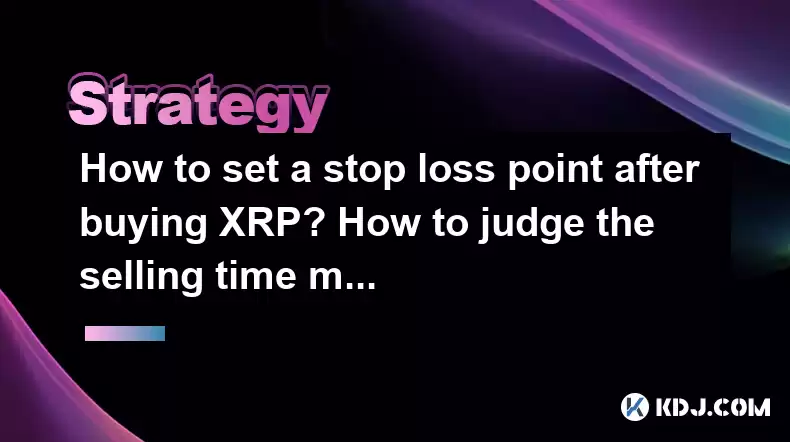-
 bitcoin
bitcoin $110918.433029 USD
-1.69% -
 ethereum
ethereum $3996.872473 USD
-2.43% -
 tether
tether $1.000594 USD
0.00% -
 bnb
bnb $1178.871834 USD
-2.38% -
 xrp
xrp $2.413973 USD
-3.47% -
 solana
solana $194.341461 USD
-4.24% -
 usd-coin
usd-coin $0.999963 USD
-0.03% -
 tron
tron $0.320092 USD
0.92% -
 dogecoin
dogecoin $0.196919 USD
-3.42% -
 cardano
cardano $0.669585 USD
-3.63% -
 hyperliquid
hyperliquid $37.485952 USD
-3.58% -
 ethena-usde
ethena-usde $1.000026 USD
-0.02% -
 chainlink
chainlink $18.018220 USD
-5.13% -
 bitcoin-cash
bitcoin-cash $523.879267 USD
-2.41% -
 stellar
stellar $0.324655 USD
-3.67%
How to set a stop loss point after buying XRP? How to judge the selling time more reasonably
To manage risk with XRP, set a stop loss at a predetermined price and use technical analysis, market sentiment, and personal goals to decide when to sell.
Apr 28, 2025 at 01:15 pm

When investing in cryptocurrencies like XRP, setting a stop loss point and determining the right time to sell are crucial steps to manage risk and maximize returns. This article will guide you through the process of setting a stop loss point after buying XRP and provide insights on how to judge the selling time more reasonably.
Understanding Stop Loss in Cryptocurrency Trading
A stop loss is an order placed with a broker to buy or sell a security when it reaches a certain price. In the context of XRP, setting a stop loss helps you limit potential losses by automatically selling your XRP if its price falls to a predetermined level. This is particularly important in the volatile cryptocurrency market, where prices can fluctuate dramatically in a short period.
How to Set a Stop Loss Point for XRP
Setting a stop loss point for XRP involves several steps that you can follow on most cryptocurrency trading platforms. Here's how you can do it:
- Log into your trading platform: Ensure you are logged into the platform where you hold your XRP.
- Navigate to the XRP trading page: Find the section where you can trade XRP.
- Select the 'Sell' option: Click on the option to sell your XRP.
- Choose 'Stop-Limit' order: Instead of a market order, select the stop-limit order type.
- Set the stop price: This is the price at which you want the stop order to be triggered. For example, if you bought XRP at $0.50, you might set the stop price at $0.45 to limit your loss to 10%.
- Set the limit price: This is the price at which you want your XRP to be sold once the stop price is reached. It should be slightly lower than the stop price to ensure the order is executed. For instance, if your stop price is $0.45, you might set the limit price at $0.44.
- Review and confirm the order: Double-check all the details and submit the order.
Factors to Consider When Setting a Stop Loss Point
When setting a stop loss point for XRP, several factors should be taken into account:
- Volatility: XRP, like other cryptocurrencies, can be highly volatile. Consider setting a wider stop loss to avoid being stopped out by normal market fluctuations.
- Investment goals: Your stop loss should align with your investment goals and risk tolerance. If you are more risk-averse, you might set a tighter stop loss.
- Market trends: Analyze the current market trends and set your stop loss accordingly. If the market is bearish, you might want to set a more conservative stop loss.
Judging the Right Time to Sell XRP
Determining the right time to sell XRP involves a combination of technical analysis, market sentiment, and personal investment goals. Here are some strategies to help you make a more informed decision:
Technical Analysis for XRP
Technical analysis involves studying historical price data and chart patterns to predict future price movements. Here are some key indicators to consider:
- Moving Averages: Look at the 50-day and 200-day moving averages. If the price of XRP crosses below these averages, it might be a signal to sell.
- Relative Strength Index (RSI): An RSI above 70 indicates that XRP might be overbought, suggesting a potential sell signal. Conversely, an RSI below 30 might indicate an oversold condition, but be cautious as it could also signal a buying opportunity.
- Support and Resistance Levels: Identify key support and resistance levels on the XRP chart. If the price breaks below a significant support level, it might be time to sell.
Market Sentiment and News
Market sentiment and news can significantly impact the price of XRP. Stay informed about the latest developments in the cryptocurrency space, particularly those related to XRP and Ripple. Here are some tips:
- Follow reputable news sources: Websites like CoinDesk, CoinTelegraph, and CryptoSlate provide up-to-date information on XRP and the broader crypto market.
- Monitor social media: Platforms like Twitter and Reddit can give you insights into the current sentiment around XRP. Look for trends and discussions that might influence the price.
- Regulatory news: Pay close attention to any regulatory news or legal developments involving Ripple, as these can have a direct impact on XRP's price.
Personal Investment Goals
Your personal investment goals should guide your decision to sell XRP. Consider the following:
- Profit targets: If you have set specific profit targets, sell your XRP when those targets are met.
- Risk management: If the price of XRP falls to a level where you are no longer comfortable with the risk, consider selling.
- Portfolio rebalancing: If XRP's performance is affecting your overall portfolio balance, you might need to sell some of your holdings to rebalance.
Using a Trailing Stop Loss
A trailing stop loss is a type of stop loss order that moves with the market price. It can be an effective way to lock in profits while still allowing for potential upside. Here's how to set a trailing stop loss for XRP:
- Log into your trading platform: Access the platform where you hold your XRP.
- Navigate to the XRP trading page: Go to the section where you can trade XRP.
- Select the 'Sell' option: Click on the option to sell your XRP.
- Choose 'Trailing Stop' order: Instead of a regular stop loss, select the trailing stop option.
- Set the trailing amount: This is the percentage or dollar amount by which the stop price will trail the market price. For example, if you set a 10% trailing stop and the price of XRP rises to $0.60, the stop price will be $0.54.
- Review and confirm the order: Double-check all the details and submit the order.
Frequently Asked Questions
Q: Can I adjust my stop loss order after it's been set?A: Yes, you can adjust your stop loss order at any time before it is triggered. Simply go back to the trading platform, find your existing order, and modify the stop price and limit price as needed.
Q: What should I do if my stop loss is triggered but the price of XRP quickly recovers?A: If your stop loss is triggered and the price of XRP quickly recovers, it might be frustrating, but it's important to stick to your trading plan. You can always buy back into XRP if you believe the recovery is sustainable. However, consider why your stop loss was triggered and whether your initial analysis was correct.
Q: How often should I review my stop loss and selling strategy for XRP?A: It's a good practice to review your stop loss and selling strategy regularly, especially in response to significant market movements or new information. Weekly reviews can help you stay on top of your investments, but you might need to adjust more frequently during periods of high volatility.
Q: Is it better to use a fixed stop loss or a trailing stop loss for XRP?A: The choice between a fixed stop loss and a trailing stop loss depends on your trading strategy and risk tolerance. A fixed stop loss provides a clear exit point, while a trailing stop loss allows you to capture more upside while still protecting against significant downturns. Consider your investment goals and the current market conditions when deciding which type of stop loss to use.
Disclaimer:info@kdj.com
The information provided is not trading advice. kdj.com does not assume any responsibility for any investments made based on the information provided in this article. Cryptocurrencies are highly volatile and it is highly recommended that you invest with caution after thorough research!
If you believe that the content used on this website infringes your copyright, please contact us immediately (info@kdj.com) and we will delete it promptly.
- Penny Assets to Watch: MUTM and the 2025 Ranking of Promising Tokens
- 2025-10-16 18:25:12
- Crypto Launch Mania: Is Snorter the Next Pepe or Shiba Inu?
- 2025-10-16 18:25:12
- Coinbase Stock: Riding the Crypto Wave - Buy, Sell, or Hold?
- 2025-10-16 18:30:01
- $BFX vs. $IONX: Unveiling the Fastest-Growing Crypto Presale and the Next Big Play
- 2025-10-16 18:30:01
- Bitcoin, Hyper, and DeepSnitch AI: Decoding the Crypto Landscape
- 2025-10-16 18:30:01
- Bitcoin Price Rollercoaster: $150K Predictions Amidst Liquidations
- 2025-10-16 18:30:15
Related knowledge

Practical parameter settings for a Bitcoin multi-timeframe moving average system
Sep 18,2025 at 10:54pm
Optimizing Timeframe Combinations for Bitcoin Trading1. Selecting appropriate timeframes is crucial when building a multi-timeframe moving average sys...

How can I filter out false breakouts in Dogecoin high-frequency trading?
Sep 22,2025 at 01:00am
Understanding False Breakouts in Dogecoin Trading1. A false breakout occurs when Dogecoin's price appears to move beyond a defined support or resistan...

Techniques for identifying tops and bottoms in the Bitcoin on-chain NVT model
Sep 20,2025 at 07:54pm
Understanding the NVT Model in Bitcoin Analysis1. The Network Value to Transactions (NVT) ratio is often described as the 'P/E ratio' of the cryptocur...

What does the surge in open interest in Bitcoincoin futures mean?
Sep 20,2025 at 11:18pm
Understanding the Surge in Dogecoin Futures Open Interest1. A surge in open interest within Dogecoin futures indicates a growing number of active cont...

How can I use the Ethereum USDT premium to gauge market sentiment?
Sep 18,2025 at 11:55pm
Understanding the Ethereum USDT Premium1. The Ethereum USDT premium refers to the price difference between USDT (Tether) traded on Ethereum-based plat...

What should I do if Ethereum staking yields decline?
Sep 20,2025 at 06:18am
Understanding the Causes Behind Declining Ethereum Staking Yields1. The Ethereum network transitioned to a proof-of-stake consensus mechanism with the...

Practical parameter settings for a Bitcoin multi-timeframe moving average system
Sep 18,2025 at 10:54pm
Optimizing Timeframe Combinations for Bitcoin Trading1. Selecting appropriate timeframes is crucial when building a multi-timeframe moving average sys...

How can I filter out false breakouts in Dogecoin high-frequency trading?
Sep 22,2025 at 01:00am
Understanding False Breakouts in Dogecoin Trading1. A false breakout occurs when Dogecoin's price appears to move beyond a defined support or resistan...

Techniques for identifying tops and bottoms in the Bitcoin on-chain NVT model
Sep 20,2025 at 07:54pm
Understanding the NVT Model in Bitcoin Analysis1. The Network Value to Transactions (NVT) ratio is often described as the 'P/E ratio' of the cryptocur...

What does the surge in open interest in Bitcoincoin futures mean?
Sep 20,2025 at 11:18pm
Understanding the Surge in Dogecoin Futures Open Interest1. A surge in open interest within Dogecoin futures indicates a growing number of active cont...

How can I use the Ethereum USDT premium to gauge market sentiment?
Sep 18,2025 at 11:55pm
Understanding the Ethereum USDT Premium1. The Ethereum USDT premium refers to the price difference between USDT (Tether) traded on Ethereum-based plat...

What should I do if Ethereum staking yields decline?
Sep 20,2025 at 06:18am
Understanding the Causes Behind Declining Ethereum Staking Yields1. The Ethereum network transitioned to a proof-of-stake consensus mechanism with the...
See all articles


























![Web3 Crypto Market Morning Report: The market is in decline, altcoins have fallen by more than 5%, Binance compensation has been received, and Memes on the Bnb chain have collectively plummeted [Vic TALK Issue 1444] Web3 Crypto Market Morning Report: The market is in decline, altcoins have fallen by more than 5%, Binance compensation has been received, and Memes on the Bnb chain have collectively plummeted [Vic TALK Issue 1444]](/uploads/2025/10/16/cryptocurrencies-news/videos/web-crypto-market-morning-report-market-decline-altcoins-fallen-binance-compensation-received-memes-bnb-chain-collectively-plummeted-vic-talk-issue/68f043c9c8b44_image_500_375.webp)















































